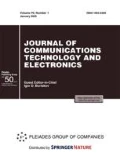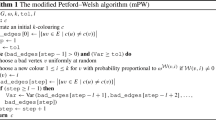Abstract
The paper addresses the combinatorial problem of edge colored clustering in graphs. A brief structured survey on the problems and their applications in communication networks and computer systems is presented. Basic mathematical formulation of the problem of edge colored clustering in graphs is described. A multicriteria problem statement is suggested. Numerical examples illustrate the considered problems.







Similar content being viewed by others
REFERENCES
L. Addario-Berry, R. E. L. Aldred, K. Dalal, and B. A. Reed, Vertex coloring edge partitions. J. Combin. Theory Ser. B 94, 237–244 (2005).
A. Ageev and A. Kononov, “Improved approximation for the max k-colored clustering problem,” in Int. Workshop on Approximation and Online Algorithms WAOA 2014, (Springer, LNCS 8952, 2015), pp. 1–10.
E. A. Albacea, “A parallel algorithm for edge-coloring of graphs with edge-disjoint cycles,” Inf. Process. Lett. 43, 309–314 (1992).
Y. M. Alhamdan and A. Kononov, “Approximability and inapproximability for maximum k-edge–colored clustering problem,” in Proc. 14th Int. Conf. CSR-2019, Novosibirsk, July 1–5, 2019 (Springer, 2019), pp. 1–13.
S. Altinakar, G. Caporossi, and A. Hertz, “On compact k-edge-coloring: a polynomial time reduction from linear to cycle,” Discr. Optim. 8, 502–512 (2011).
E. Angel, E. Bampis, A. Kononov, D. Paparas, E. Pountourakis, and V. Zissimopoulos, “Clustering on k-edge-colored graphs,” in K. Chatterjee and J. Sgall (eds), MFCS, Klosterneuburg, Austria, 2013, (LNCS 8087, Springer, 2013), pp. 50–61.
E. Angel, E. Bampis, A. V. Kononov, D. Paparas, E. Pountourakis, and V. Zissimopoulos, “Clustering on k-edge-colored graphs,” Discr. Appl. Math. 211, 15–22 (2016).
M. P. de Aragao and E. Uchoa, “The -connected assignment problem,” Eur. J. Oper. Res. 118, 127–138 (1999).
J. Araujo, N. Nisse, and S. Perennes, “Weighted coloring in trees,” SIAM J. Discrete Math. 28 (4), 2029–2041 (2014).
J. Araujo, J. Baste, and I. Sau, “Ruling out FPT algorithms for weighted coloring on forests,” Theor. Comput. Sci. 729, 11–19 (2018).
J. Araujo, V. A. Campos, C. V. G. C. Lima, V. F. Santos, I. Sau, and A. Silva, “Dual parameterization of weighted coloring,” Algorithmica 82, 2316–2336 (2020).
E. Bampis, A. Kononov, G. Lucarelli, and I. Milis, “Bounded max-colorings of graphs,” J. Discr. Algorithms 26, 56–68 (2014).
N. Barnier and P. Brisset, “Graph coloring for air traffic flow management,” Ann. Oper. Res. 130, 163–178 (2004).
B. Beauquier, S. Perennes, and D. Toth, “All-to-all routing and coloring in weighted tree of rings,” in Proc. Eleventh Ann. ACM Symp. on Parallel Algorithms and Architectures SPAA’99,Saint-Maio, France, June 27–30, 1999, pp. 185–190.
A. Benjamin, G. Chartrand, and P. Zhang, “The Fascinating World of Graph Theory,” (Princeton Univ. Press, Princeton, NJ, 2015).
R. Benkoczi, R. Daha, and D. R. Gaur, “Exact algorithms for weighted coloring in special classes of tree and cactus graphs,” in: V. Makinen, S. J. Pugglisi, and L. Salmela (eds), Proc. 27th Int. Workshop on Combinatorial Algorithms IWOCA 2016 (Springer, LNCS 9843, 2016), pp. 347–358.
G. Bongiovanni, D. Coppersmith, and C. K. Wong, “An optimum time slot assignment algorithm for an SS/TDMA system with variable number of transponders,” IEEE Trans. on Commun. 29, 721–726 (1981).
D. Bozdag, A. H. Gebremedhin, F. Manne, E. G. Boman, and U. Catalyurek, “A framework for scalable greedy coloring on distributed memory parallel computers,” J. Parallel and Distributed Computing 68, 515–535 (2008).
L. Cai and O.-Y. Leung, “Alternating path and colored clustering,” Electr. Preprint, (Jul. 27, 2018). http://arxiv. org/abs/1807.10531 [cs.DS].
T. H. Cormen, C. E. Leiserson, and R. L. Rivest, Introduction to Algorithms, 3rd ed. (MIT Press & McGraw-Hill, 2009).
M. Demange, B. Escoffier, J. Monnot, and V. T. Paschos, “Weighted coloring on planar, bipartite and split graphs: complexity and approximation,” Discr. Appl. Math. 157, 819–832 (2009).
M. Demange, D. de Werra, J. Monnot, and V. Th. Paschos, “Time slot scheduling of compatible jobs,” J. of Scheduling 10, 111–127 (2007).
B. Escoffier, J. Monnot, and V. T. Paschos, “Weighted coloring: further complexity and approximability results,” Inf. Proc. Lett. 97 (3), 98–103 (2006).
U. Feige and J. Vondrak, “Approximation algorithm for allocation problem improving the factor 1 – 1/e,” in Proc. 47 Ann. IEEE Symp. on Foundations of Computer Science FOCS 2006 (IEEE, New York, 2006), pp. 667–676.
G. Finke, V. Jost, M. Queyranne, and A. Sebo, “Batch processing with interval graph compatibilities between tasks,” Discr. Appl. Math. 156, 556–568 (2008).
M. R. Garey and D. S. Johnson, Computers and Intractability. The Guide to the Theory of NPCompleteness (W. H. Freeman and Company, San Francisco, 1979).
A. Gibbons and W. Rytter, “Optimally edge-coloring outerplanar graphs is IN NC,” Theor. Comp. Sci. 71, 401–411 (1990).
R. Govindarajan and S. Rengarajan, “Buffer allocation in regular dataflow networks: an approach based on coloring circular-arc graphs,” in Proc. 3rd Int. Conf. on High Performance Computing (HiPC), IEEE, Trivandum, India, Dec. 19–22, 1996 (IEEE, New York, 1996), pp. 419–424.
D. J. Guan and X. Zhu, “A coloring problem for weighted graphs,” Inf. Proc. Lett. 61 (2), 77–81 (1997).
A. Hawbani, X. Wang, H. Kuhlani, A. Ghannami, M. U. Farooq, and Y. Al-sharabi, “Extracting overlapped sub-regions in wireless sensor networks,” Wireless Networks 25, 4705–4726 (2019).
T. M. Hedetniemi, S. T. Hedetniemi, and A. L. Liestman, “A survey of gossiping and broadcasting in communication networks,” Networks 18, 319–349 (1988).
K. Jansen and P. Scheffler, “Generalized coloring for tree-like graphs,” Discr. Appl. Math. 75 (2), 135–155 (1995).
T. Januaro, S. Urrutia, C. C. Ribeiro, and D. de Werra, “Edge coloring: a natural model for sport scheduling,” Eur. J. Oper. Res. 254 (1), 1–8 (2016).
T. R. Jensen and B. Toft, Graph Coloring Problems (Wiley, New York, 1995).
D. S. Johnson and M. A. Trick, (eds), Cliques, Coloring, and Satisfiability, DIMACS Ser. in Discr. Math. & Theor. Computer Sci. (AMS, Providence, 1996), Vol. 20.
A. Kesselman and K. Kogan, “Nonpreemptive scheduling of optical switches,” IEEE Trans. on Commun. 55, 1212–1219 (2007).
J. M. Kleinberg and K. Ligett, “Information-sharing and privacy in social networks,” Games & Econ. Behavior 82, 702–716 (2013).
C. T. Kovalyov, M. Y. Ng, and T. C. E. Cheng, “Fixed interval scheduling: models, applications, computational complexity and algorithms,” Eur. J. Oper. Res. 178, 331–342 (2007).
M. Kubale, “The complexity of scheduling independent two-processor tasks on dedicated processors,” Inf. Proc. Lett. 24, 141–147 (1987).
M. Kubale and K. Piwakowski, “A linear time algorithm for edge coloring of binomial trees,” Discr. Math. 150, 247–256 (1996).
R. Labahn, S. T. Hedetniemi, and R. Laskar, “Periodic gossiping on trees,” Discr. Appl. Math. 53, 235–245 (1994).
X. Lai and Z. Lu, “Multistart iterated tabu search for bandwidth coloring problem,” Comp. & Oper. Res. 40, 1401–1409 (2013).
M. S. Levin, On combinatorial clustering: literature review, methods, examples. J. Commun. Technol. Electron. 60 (12), 1403–1428 (2015).
M. S. Levin, “Note on k-edge colored clustering (preliminary version),” Preprint, (2022). https://doi.org/10.13140/RG.2.2.12933.22248
R. Lewis, J. Thompson, C. Mumford, and J. Gillard, “A wide-ranging computational comparison of highperformance graph colouring algorithms,” Comp. and Oper. Res. 39, 1933–1955 (2012).
R. M. R. Lewis, A Guide to Graph Coloring: Algorithms and Applications (Springer, 2016).
A. L. Liesman and D. Richards, “Network communication in edge-colored graphs: gossiping,” IEEE Trans. Parallel Distrib. Systems 4, 438–445 (1993).
S.-M. Lo, W.-H. Lin, C. Chen, and Y.-C. Tseng, “Optimal coloring for data collection in tree-based wireless sensor networks,” Theor. Comput. Sci. 700, 23–36 (2017).
G. Lucarelli, I. Milis, and V. Th. Paschos, “Maximum edge coloring of trees,” Electr. Preprint, (Jan. 26, 2009). http://arxiv.org/abs/0901.4002 [cs.DS].
G. Lucarelli and I. Mills, “Improved approximation algorithms for the Max Edge-Coloring problem,” Inf. Proc. Lett. 111 (16), 819–823 (2011).
R. Mahapatra, S. Samanta, T. Allahviranloo, and M. Pal, “Radio fuzzy graphs and assignment of frequency in radio stations,” Comput. & Appl. Math. 38 (3), art. 117, 1–20 (2019).
R. Mahapatra, S. Samanta, and M. Pal, “Applications of edge colouring of fuzzy graphs. Informatica” 31, 313–330 (2020).
E. Malaguti and P. Toth, “An evolutionary approach for bandwidth multicoloring problems,” Eur. J. Oper. Res. 189, 638–651 (2008).
E. Malaguti, M. Monaci, and P. Toth, “Models and heuristic algorithms for a weighted vertex coloring problem,” J. Heuristics 15, 503–526 (2009).
E. Malaguti and P. Toth, “A survey on vertex coloring problems,” Int. Trans. in Oper. Res. 17, 1–34 (2010).
C. McDiarmid and B. Reed, “Channel assignment and weighted coloring,” Networks 36, 114–117 (2000).
A. Mishra, S. Banerjee, and W. Arbaugh, “Weighted coloring based channel assignment for WLANs,” SIGMOBILE Mob. Comput. Commun. Rev. 9 (3), 19–31 (2005).
S. Mitchell and S. Hedetniemi, “Linear algorithms for edge coloring trees and unicyclic graphs,” Inf. Process. Lett. 9, 110–112 (1979).
A. Nadolski, “Compact cyclic edge-colorings of graphs,” Discr. Math. 308, 2407–2417 (2008).
A. Navarra, C. M. Pinotti, and A. Formisano, “Distributed colorings for collision-free routing in sink-centric sensor networks,” J. Discrete Algorithms 14, 232–247 (2012).
P. Panigrahi, “A survey on radio k-colorings of graphs,” AKSE Int. J. Graphs & Combin. 6 (1), 161–169 (2009).
S. V. Pemmaraju, R. Raman, and K. R. Varadarajan, “Buffer minimization using max-coloring,” in Proc. 15th Ann. ACM-SIAM Symp. on Discrete Algorithms (SODA’04), 2004, pp. 562–571.
S. V. Pemmaraju and R. Raman, “Approximation algorithms for the max-coloring problem,” in Proc. 32nd Int. Colloquium on Automata, Languages and Programming (ICALPT05), 2005 (LNCS 3580, Springer, 2005). pp. 1064–1075.
N. R. Sabar, M. Ayob, R. Qu, and G. Kendall, “A graph coloring constructive hyper-heuristic for examination timetabling problems,” Appl. Intell. 37 (1), 1–11 (2012).
L. Saha and P. Panigrahi, “A lower bound for radio k‑chromatic number,” Discr. Appl. Math. 192, 87–100 (2015).
D. Sannyasi, “Improved approximation algorithms for weighted edge coloring of graphs,” Electr. Preprint, (Dec. 30, 2021). http://arxiv.org/abs/2012.15056 [cs.DS].
Q. Yan, X. Tang, Q. Chen, and M. Cheng, “Placement delivery array design through strong edge coloring of bipartite graphs,” IEEE Commun. Lett. 22, 236–239 (2018).
Author information
Authors and Affiliations
Corresponding author
Ethics declarations
The author declares that he has no conflicts of interest.
Additional information
Translated by E. Oborin
Rights and permissions
About this article
Cite this article
Levin, M.S. Clustering Models Based on Graph Edge Coloring. J. Commun. Technol. Electron. 67, 1570–1577 (2022). https://doi.org/10.1134/S1064226922120130
Received:
Revised:
Accepted:
Published:
Issue Date:
DOI: https://doi.org/10.1134/S1064226922120130




